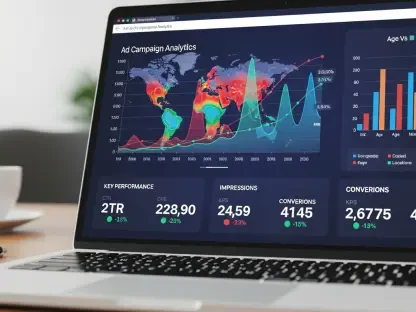Imagine launching a Google Ads Search campaign in a fiercely competitive industry, only to watch the budget drain with minimal conversions due to skyrocketing keyword costs. This scenario is all too common for advertisers striving to stand out in crowded markets. The challenge lies in reaching the right users at the right time without wasting money on irrelevant clicks. This guide offers a solution by detailing how to layer audience targeting over traditional keyword strategies in Google Ads Search campaigns. By implementing these methods, advertisers can significantly enhance campaign performance, reduce wasted spending, and gain actionable insights applicable across multiple platforms.
The purpose of this guide is to provide a clear, step-by-step approach to integrating audience targeting layers into Google Ads Search campaigns. It aims to help advertisers achieve higher precision in reaching potential customers, ultimately improving return on investment. Whether operating in high-cost industries or managing limited budgets, the strategies outlined here are designed to refine ad delivery and maximize impact.
This guide also underscores the broader relevance of audience targeting in today’s digital advertising landscape. Beyond immediate campaign results, the data gathered from these tactics can inform strategies on other platforms like Microsoft Ads, Meta Ads, and TikTok. By following the detailed instructions provided, advertisers will be equipped to navigate the complexities of audience targeting and stay ahead in an ever-evolving pay-per-click (PPC) environment.
Unleashing the Power of Audience Targeting in Google Ads Search Campaigns
Audience targeting has emerged as a transformative approach for Google Ads Search campaigns, offering a way to refine reach beyond basic keyword strategies and adapt to the evolving digital landscape. In industries where competition drives up costs, layering audience data allows advertisers to pinpoint users more likely to convert. This method adds a critical dimension to campaigns by focusing on who is searching, not just what they are searching for, thereby enhancing overall effectiveness.
The significance of this strategy lies in its ability to deliver a competitive edge. By combining audience insights with keyword targeting, advertisers can optimize their ad spend and achieve better results even in saturated markets. This approach ensures that ads are shown to individuals with specific characteristics or behaviors, increasing the likelihood of engagement and reducing irrelevant impressions.
Moreover, the benefits of audience targeting extend beyond Google Ads Search campaigns. The insights gained from layering audience data can be applied to other advertising platforms, including Microsoft Ads, Meta Ads, and TikTok. This cross-platform applicability makes audience targeting a versatile tool, enabling advertisers to build more cohesive and data-driven marketing strategies across their digital efforts.
Why Audience Targeting Matters in Today’s PPC Landscape
In the current PPC landscape, the role of audience targeting has evolved to become a cornerstone of effective advertising. With keyword costs continuing to rise, especially in competitive sectors, advertisers face increasing pressure to ensure every dollar spent yields measurable results. Audience layering addresses this challenge by adding precision to campaigns, allowing for more efficient allocation of budgets.
The value of richer performance data cannot be overstated in this context, as it plays a crucial role in enhancing advertising strategies. By integrating audience targeting, advertisers gain deeper insights into user behavior and preferences, which can inform not only Search campaigns but also other campaign types. This data-driven approach helps in identifying high-performing segments, enabling continuous optimization and reducing the risk of overspending on underperforming areas.
Furthermore, the impact of audience targeting extends across various platforms and campaign formats. As digital advertising grows more complex, the ability to enhance ad spend efficiency through audience insights provides a significant advantage. Advertisers who adopt this strategy are better positioned to navigate market dynamics and achieve sustainable growth in their PPC endeavors.
Mastering Audience Targeting Layers: Key Types and Strategies
To effectively implement audience targeting layers in Google Ads Search campaigns, advertisers must understand the different audience types and how to apply them strategically. This section provides a comprehensive breakdown of actionable steps to harness these layers. Each step focuses on a specific audience type, offering detailed guidance on maximizing its potential.
The process involves not only selecting the right audience segments but also testing and refining combinations to suit specific business goals. By following these steps, advertisers can build campaigns that are both targeted and adaptable. The strategies outlined here aim to balance reach with relevance, ensuring ads connect with users most likely to take action.
Beyond individual steps, a key aspect of mastering audience targeting lies in continuous experimentation and data analysis. Advertisers are encouraged to approach this process methodically, leveraging Google Ads’ tools to monitor performance and adjust tactics. The following subsections delve into each audience type, providing practical advice for implementation.
Step 1: Harnessing Demographic Audiences for Precision
Demographic targeting in Google Ads allows advertisers to refine their audience based on characteristics such as parental status, marital status, education level, homeownership, and employment data. These options provide a foundation for ensuring that ads are shown to users who match the ideal customer profile, helping to minimize wasted spend by narrowing the focus to relevant demographics.
While demographic targeting offers valuable precision, it is important to recognize its limitations in terms of accuracy. Google’s data may not always perfectly reflect a user’s current situation, which can lead to mismatches. For this reason, using demographic layers for inclusion rather than exclusion is recommended to avoid overly restrictive targeting that could limit campaign reach.
Advertisers should approach demographic targeting as a starting point for audience refinement. By layering these characteristics over keyword strategies, it becomes possible to create a more focused campaign without sacrificing potential impressions. Testing different demographic combinations can also reveal unexpected opportunities for engagement within specific user groups.
Tip: Focus on Inclusion to Maximize Reach
When utilizing demographic targeting, prioritizing inclusion over exclusion ensures that campaigns maintain a broad enough reach to capture potential customers. Excluding certain demographics can inadvertently eliminate viable prospects due to data inaccuracies. Instead, focusing on who to include helps in casting a wider net while still refining the audience to align with business objectives.
Step 2: Crafting Custom Audiences for Tailored Impact
Custom audiences offer unparalleled flexibility by allowing advertisers to create segments tailored to specific business needs. These can be built using customer lists, search behavior, purchase intent signals, website visits, and app usage data. This step enables the design of highly relevant audience groups when standard options do not fully meet campaign requirements.
The process of creating custom audiences involves identifying key user behaviors or characteristics that align with marketing goals. For instance, targeting users who have searched for related terms on Google or visited specific pages on a website can help in reaching individuals with demonstrated interest. This customization ensures that ads are delivered to a precisely defined segment.
Implementing custom audiences effectively requires careful planning and segmentation. Advertisers should focus on building audiences that reflect the nuances of their target market, ensuring that each segment is actionable. This step sets the stage for pairing these tailored groups with other targeting methods to enhance campaign outcomes.
Insight: Pair with High-Intent Keywords for Profitability
Combining custom audiences with high-intent keywords can significantly boost conversion rates and profitability. High-intent keywords indicate active interest or readiness to purchase, and layering custom audiences ensures that these searches come from the most relevant users. This synergy maximizes the impact of ad spend by focusing on users with both intent and alignment to the brand.
Step 3: Re-Engaging with Remarketing Audiences
Remarketing audiences target users who have previously interacted with a brand, such as those who visited a website, made a purchase, or viewed specific products. This step focuses ad spending on individuals already familiar with the business, increasing the likelihood of conversion. Remarketing is particularly effective for maintaining engagement with high-intent users.
This approach proves especially valuable in industries with longer sales cycles or higher-priced offerings. Users who have shown prior interest often need multiple touchpoints before committing, and remarketing ensures that the brand remains top of mind. By re-engaging these users, advertisers can nurture leads more effectively within Search campaigns.
Setting up remarketing audiences requires a clear understanding of past user interactions and their relevance to current goals. Advertisers should segment these audiences based on specific actions, such as cart abandonment or page views, to tailor messaging accordingly. This targeted re-engagement can lead to substantial improvements in campaign performance.
Tip: Prioritize High-Value Products for Remarketing
When implementing remarketing, focusing on high-value or complex products can maximize return on investment. These offerings often require more consideration, and targeting users who have already shown interest in them ensures that ad spend is directed toward prospects with higher potential revenue. This prioritization enhances the efficiency of remarketing efforts.
Step 4: Aligning with Interests and Affinity Audiences
Interest-based targeting focuses on users who exhibit specific hobbies or passions, pairing well with keyword strategies in Search campaigns. This approach ensures that ads reach individuals who are not only searching for relevant terms but also have a genuine interest in the product or service. It helps filter out casual searchers who may not convert.
Affinity audiences take this a step further by targeting users with strong, long-term engagement in a particular topic or category, ensuring that the ads reach individuals who are genuinely passionate about the subject. These users have consistently interacted with related content online, indicating a deeper connection to the niche. Layering affinity audiences over keywords refines the audience to those with sustained interest, enhancing ad relevance.
Advertisers should explore various interest and affinity categories to identify those most aligned with their offerings. Testing different segments can reveal which groups drive the best engagement and conversion rates. This step is crucial for optimizing budget allocation and ensuring ads resonate with the intended audience.
Insight: Reduce Wasted Spend with Focused Interests
Using interest and affinity audiences helps reduce wasted spend by concentrating budgets on qualified prospects. By targeting users with demonstrated interest in a category, advertisers can avoid irrelevant clicks from users unlikely to convert. This focused approach ensures that ad spend contributes directly to meaningful outcomes.
Step 5: Capturing Ready-to-Buy Users with In-Market Audiences
In-market audiences consist of users actively researching products or services and nearing a purchase decision, positioning ads in front of individuals at the bottom of the sales funnel where conversion likelihood is highest. Targeting these users ensures that campaigns capitalize on immediate buying intent.
The power of in-market audiences lies in their timeliness, as they represent users who are actively engaged in the buying process. Unlike broader audience segments, these users have shown recent activity indicating readiness to act, such as comparing products or seeking reviews. Layering this audience over Search campaigns helps in intercepting them at a critical decision-making stage.
Advertisers should identify in-market categories most relevant to their business and integrate them into existing campaigns. This step requires monitoring performance closely to ensure that the audience remains aligned with campaign objectives. By focusing on ready-to-buy users, advertisers can drive quicker results and improve overall efficiency.
Tip: Combine with Specific Keywords for Immediate Results
Pairing in-market audiences with specific, high-intent keywords can lead to immediate campaign results. This combination targets users who are both actively researching and searching for precise terms related to a purchase. Such precision ensures that ads are delivered at the optimal moment, enhancing conversion potential.
Step 6: Testing Combinations with Real-World Examples
Testing combinations of audience layers with keywords is a practical way to identify effective strategies for specific industries. For example, targeting car buyers with an in-market audience for vehicles, or homeowners with demographic layers for interior design searches, can yield targeted results. This step encourages experimentation with various pairings to uncover what resonates most.
Other examples include layering custom audiences of users searching for accounting software with related keywords, or using affinity audiences of avid investors for financial strategy queries. For branded searches, adding remarketing audiences of recent website visitors can re-engage high-intent users. These real-world scenarios provide a starting point for customization.
Advertisers should approach testing with a structured mindset, documenting which combinations drive the best performance. By using these examples as inspiration, it becomes possible to adapt strategies to unique business needs. This step highlights the importance of flexibility and creativity in audience targeting.
Warning: Start Small to Avoid Overspend
When testing audience and keyword combinations, starting with small budgets is advisable to manage costs effectively and avoid unnecessary expenses. Large-scale tests without prior data can lead to significant overspending if combinations underperform, so caution is key. Beginning with limited experiments allows for controlled evaluation and minimizes financial risk during the learning phase.
Step 7: Observing Before Targeting with Observation Mode
Using Observation mode in Google Ads is a critical step for collecting performance data on audiences without restricting campaign reach. This mode allows advertisers to monitor how different audience segments interact with ads before committing to full targeting. It serves as a low-risk way to gather insights in competitive or high-cost industries.
Testing multiple audience types simultaneously in Observation mode can reveal which demographics, interests, or intent signals drive the best results, helping to identify high-performing segments without impacting overall campaign delivery. The data collected during this phase is invaluable for making informed targeting decisions.
Advertisers should leverage Observation mode as a foundational step before scaling efforts. By building a comprehensive understanding of audience behavior, it becomes easier to allocate budgets strategically. This step ensures that future targeting decisions are grounded in solid performance metrics, optimizing long-term success.
Insight: Build a Data Baseline for Smarter Decisions
Observation mode provides a critical data baseline that informs smarter targeting decisions. The insights gained from monitoring audience performance enable advertisers to scale campaigns with confidence, focusing on segments that demonstrate strong potential. This data-driven foundation is essential for achieving sustainable campaign growth.
Key Takeaways for Implementing Audience Targeting Layers
This section consolidates the essential strategies for integrating audience targeting layers into Google Ads Search campaigns. These points serve as a quick reference for advertisers looking to enhance their approach:
- Use demographic targeting for inclusion to refine reach without over-limiting.
- Create custom audiences for tailored segments that align with business goals.
- Leverage remarketing to reconnect with high-intent users.
- Pair interests and affinity audiences with keywords to focus on qualified searchers.
- Target in-market audiences to capture users ready to convert.
- Test combinations using real-world scenarios and start with Observation mode.
- Use performance data to guide future targeting decisions.
Expanding Insights Beyond Google Ads: Broader Applications and Trends
The insights derived from audience targeting in Google Ads Search campaigns hold significant value beyond a single platform, and applying these learnings to other advertising channels, such as Meta Ads, TikTok Ads, and Microsoft Ads, can greatly enhance overall digital marketing strategies. The data collected offers a starting point for testing similar audience segments across different environments.
When extending these tactics to Microsoft Ads, advertisers should replicate successful Google Ads setups while optimizing separately for performance differences to ensure the best results on each platform. Microsoft Ads often mirrors Google’s features but may yield varying results, necessitating independent adjustments. This cross-platform approach broadens reach and diversifies advertising impact across search engines and content networks.
Looking ahead, the importance of audience layering in cross-platform advertising continues to grow as a key strategy for reaching diverse consumer segments effectively. However, challenges such as evolving privacy regulations may impact data accuracy and availability. Advertisers must stay informed about these trends and adapt strategies accordingly to maintain precision and effectiveness in their targeting efforts.
Final Thoughts: Elevate Your Google Ads with Audience Layers
Reflecting on the journey through audience targeting layers, it became clear that this approach had transformed Google Ads performance for many advertisers. The detailed steps provided had equipped users with the tools to refine their campaigns, ensuring ads reached the most relevant individuals. Each strategy, from demographic inclusion to in-market precision, had played a pivotal role in optimizing results.
Moving forward, advertisers were encouraged to take incremental steps by initiating small-scale tests in Observation mode before scaling up. The focus has shifted to building on the data-driven insights gained, allowing for continuous refinement of audience segments. Exploring advanced combinations and adapting to emerging privacy constraints were identified as critical next steps for sustained success.
Ultimately, the path to mastery in audience targeting has been laid out with actionable guidance, and advertisers are urged to delve deeper into cross-platform applications. By leveraging their Google Ads data to inform broader strategies and maintaining a commitment to testing and optimization, the potential for long-term growth in digital advertising has been firmly established.









